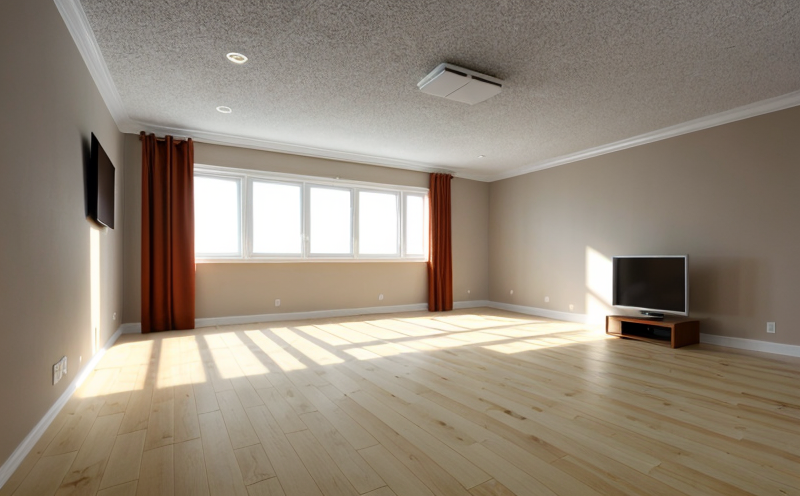ASTM E2611 Normal Incidence Sound Transmission Testing
The ASTM E2611 standard provides a method to measure sound transmission through building and room partitions using normal incidence testing. This technique is essential for ensuring that walls, floors, and ceilings meet the required acoustic performance standards in various environments such as residential homes, offices, and public spaces.
Under this test procedure, a calibrated noise source generates sound waves at specific frequencies across a broad range of audio bands. These sound waves are then transmitted through the partition under test (POT) and recorded on the receiving side using an array of microphones. The difference in decibel levels between the incoming and outgoing signals is measured to determine the sound transmission loss (STL). STL values help assess how effectively a material or assembly blocks unwanted noise.
ASTM E2611 specifies that tests must be conducted at 500, 1000, 2000, and 4000 Hz frequencies. This range covers the most sensitive human hearing areas. The testing setup includes a sound source, microphones placed both on the noise-producing side and receiving side of the partition, and an anechoic chamber to minimize reflections.
For accurate results, specimen preparation is critical. Specimens must be cut to standard sizes (typically 1200 mm x 1200 mm for walls) with any edges smoothed or rounded to prevent edge effects which could distort the test outcomes. The specimens are then mounted between two flanking enclosures that mimic the real-world environment they will encounter.
The ASTM E2611 standard also outlines procedures for handling test results, including averaging multiple measurements and accounting for temperature variations in the testing environment. This ensures consistent and repeatable results across different samples and conditions.
Understanding STL values is crucial when designing spaces that need to maintain a high level of acoustic comfort. For instance, partitions with higher STL ratings can significantly reduce noise pollution in residential areas or improve concentration levels in open-plan offices.
- Frequency Bands: 500 Hz, 1000 Hz, 2000 Hz, and 4000 Hz
- Microphone Array: Used for accurate STL measurement
- Anechoic Chamber: Necessary to minimize background noise interference
- Flanking Enclosures: Mimic real-world conditions for more reliable results
By adhering to the ASTM E2611 standard, laboratories ensure that their testing methods are consistent with international best practices. This is particularly important in sectors like architecture and construction where sound insulation plays a vital role in creating comfortable living and working environments.
Why It Matters
The importance of ASTM E2611 cannot be overstated, especially in the context of modern urban planning and building design. Noise pollution is a significant issue that affects public health and well-being. Sound transmission testing ensures that buildings are designed to minimize noise from external sources such as traffic or neighbors.
In residential areas, low STL ratings indicate effective sound insulation between homes, leading to better privacy and comfort. In commercial settings like offices and schools, high STL values help maintain a quiet environment conducive to productivity and learning.
The ASTM E2611 method also aids in meeting regulatory requirements set by various countries. For example, the European Union’s Building Regulations (EU) mandate minimum sound insulation levels for new constructions. By conducting ASTM E2611 tests, developers can ensure compliance with these regulations and avoid potential penalties.
Furthermore, this testing method is instrumental in R&D processes where innovative materials or designs are being developed to improve acoustic performance. The results provide valuable insights into the effectiveness of these innovations, guiding further development efforts.
Benefits
Conducting ASTM E2611 tests offers numerous benefits that extend beyond mere compliance with regulations:
- Enhanced Comfort: Effective sound insulation leads to more comfortable living and working spaces, reducing stress and enhancing overall well-being.
- Better Compliance: Ensures adherence to international standards like ASTM E2611, which is crucial for avoiding legal issues in many jurisdictions.
- Innovation Support: Provides data that can be used to refine materials and designs aimed at improving acoustic performance.
- Improved Reputation: Demonstrates a commitment to quality and safety, enhancing the reputation of developers, contractors, and manufacturers.
The results from ASTM E2611 testing are not only useful for regulatory compliance but also for internal quality control within organizations. Regular testing can help identify areas where improvements are needed, ensuring continuous enhancement of acoustic performance.
Moreover, the data obtained through these tests can be used in marketing strategies to highlight the superior acoustic properties of products or services, making them more attractive to environmentally conscious consumers and businesses.
Quality and Reliability Assurance
- Consistent Results: ASTM E2611 ensures that tests are conducted under controlled conditions, leading to consistent STL measurements.
- Airborne Noise Reduction: The test evaluates how well a partition reduces airborne noise, which is crucial for maintaining quiet environments.
- Compliance Verification: Ensures that building materials and assemblies meet the required standards set by international regulations.
- Data Transparency: Detailed reporting allows stakeholders to understand the performance of each specimen tested.
The ASTM E2611 method is designed to provide reliable data that can be used for decision-making processes. By adhering strictly to this standard, laboratories and testing facilities ensure that their results are credible and can be trusted by industry professionals and regulatory bodies alike.
Regular maintenance of equipment and adherence to strict calibration protocols further enhance the reliability of the test results. This is particularly important in high-stakes applications such as hospital construction or luxury residential projects where sound insulation is a critical factor.





